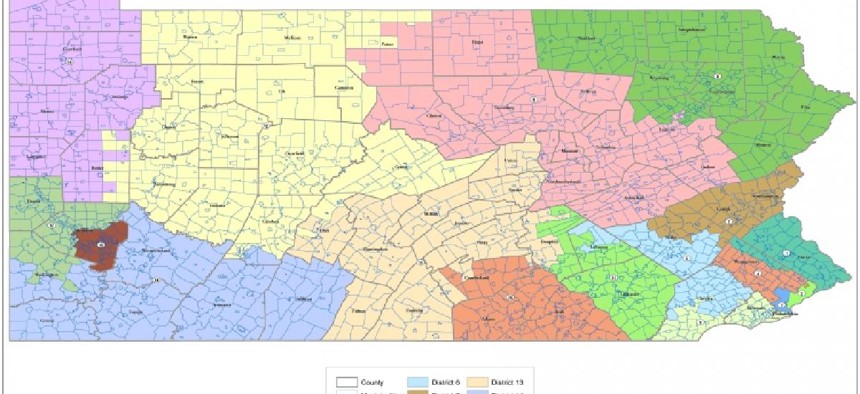General Assembly
What we know about the House GOP’s preliminary congressional map

Amanda Holt’s draft congressional map The Pennsylvania House Republican Caucus
House Republicans took a long-awaited step this week in the state’s congressional redistricting process, releasing a draft congressional map that will serve as a framework for development of the state’s new congressional districts.
House State Government Committee Chair Seth Grove announced Wednesday that the committee selected a citizen-submitted map drawn by former GOP Lehigh County Commissioner and redistricting reform advocate Amanda Holt – a map that will serve as a starting point as lawmakers look to craft a plan that will get Gov. Tom Wolf’s signature.
Here’s what we know about the map so far.
What does the map look like?
Holt’s map divides the state up into 17 congressional districts – one less district than the last map that was drawn by the Pennsylvania Supreme Court in 2018. That’s because Pennsylvania lost a congressional seat thanks to the latest U.S. Census data.
The preliminary map, available for inspection and public comment, divides the congressional districts relatively equally in terms of population, with each district made up of approximately 764,865 residents.
Grove, in a press release, said the map was selected because it was drawn “without political influence,” noting that it meets equal population requirements, limits splitting up government subdivisions, such as townships and counties, and includes districts that are as compact as possible.
Grove touted the process by which the map was selected, stressing that it was not drawn by legislators and that the public will have a chance to offer comments before a vote is taken on the draft map.
“This is a historic step forward in transparency and good government,” he said.
What are the initial reactions to the preliminary map?
Reactions to the map so far have been mixed, with some redistricting reform advocates expressing optimism that the draft map was drawn by a citizen, not a politician.
Advocates from Draw the Lines PA and RepresentUs, both of which have advocated for reforms to the state’s redistricting process, also expressed a sense of caution over the next steps of the mapmaking process.
David Thornburgh, chair of Draw the Lines PA and president and CEO of the Committee of Seventy, said the House State Government Committee should publish a narrative to explain how the map was drawn.
“They should explain why every district is the way it is. It is difficult to make sense of the choices made on the map without an accompanying narrative,” Thornburgh said in a statement. “Our Citizens’ Map did just that, providing a thorough narrative explaining the choices our mappers made. The General Assembly should do the same.”
Joe Kabourek, the senior campaign director for RepresentUS, said Pennsylvanians should have enough time to be able to thoroughly study the draft map and make sure the end product aligns with any public input that is offered.
“Residents need time to study the map to ensure all public input was taken seriously, and lawmakers need to be transparent about any changes they make and how those decisions were made before any final maps are adopted,” Kabourek said.
Certain districts have already prompted concern from Democrats and central Pennsylvania residents, who worry the Harrisburg metropolitan area has been split up in a way that benefits Republicans.
According to a FiveThirtyEight analysis of the draft proposal, which examines the difference between the partisan lean of the state’s median district and the state as a whole, the map would have a partisan lean of +7.3 in the Republicans’ favor, compared to the current map’s R+2.3 lean.
What are the next steps?
This is just the beginning for this map. Lawmakers are holding hearings to receive feedback on the preliminary map before the amendment and approval process. The House State Government Committee is set to meet Thursday evening to review the map and Monday to vote on it. The map was also introduced as a standalone bill, so citizens can follow along with any changes and votes.
The Senate will be introducing a map, too. State Sens. David Argall and Sharif Street announced they will be unveiling a bipartisan map as early as next week. Which map the Republican-controlled legislature will favor is still unknown, and with more public comment and amendments on the way, it’s unlikely that this map will be the same before final approval.
“The introduction of this map is a starting point, and we look forward to hearing the thoughts of residents across Pennsylvania about how this map would impact their community and how they are represented in Washington, D.C.,” Grove said.
Whatever map the General Assembly decides on must be approved by both the House and Senate before going to Wolf. A final vote isn’t expected until January, at the earliest.
